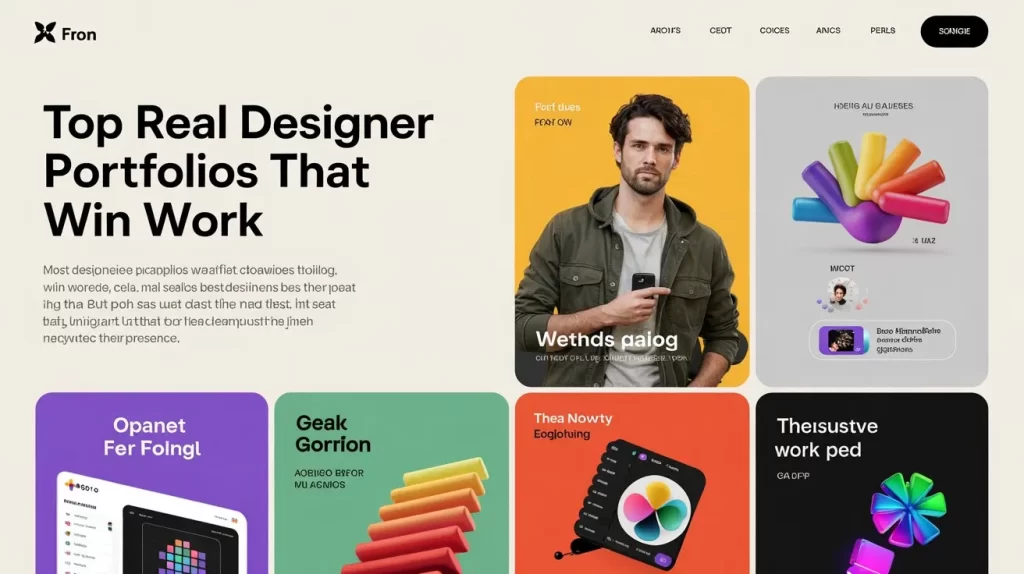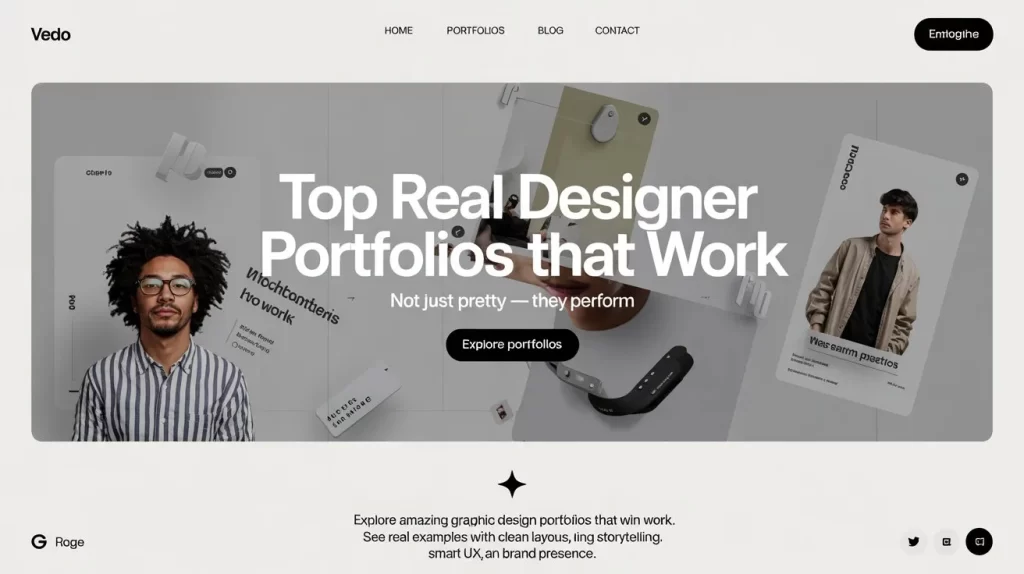Not Just Pretty — They Perform
Most graphic designers build their portfolio hoping it speaks for itself. But the best portfolios don’t just speak — they convert.
They lead with clarity, express brand identity, and create trust. They’re built with intention, and their structure, visuals, and storytelling are designed to move the visitor from curiosity to action.
This post unpacks real-world portfolio website examples that perform. Not because they’re trendy. But because they reflect excellent creative judgment, structure, UX, and a clear business goal.

What Great Designer Portfolios Do Differently
Across every amazing graphic design portfolio that works, we see five recurring qualities:
- A strong opening (hero image or tagline) that defines the designer’s identity
- Clear navigation — often one-page or shallow hierarchy
- Case studies that tell stories, not just display images
- Seamless UX and responsive design
- A personal tone, without being overly self-focused
You’re not just designing for peers. You’re designing for clients, collaborators, and decision-makers who may not speak design.
Suggested Posts:
• Local SEO for Ecommerce
• User-Generated Content in Ecommerce
• Leverage Social Proof for Ecommerce Conversions
Now, let’s break down the portfolios that do this beautifully.
1. Tobias van Schneider – Designer. Writer. Thinker.
Why it works:
Tobias doesn’t just show work — he shows thinking. The homepage opens with a personal tone and structured CTAs. His project index is minimal, image-led, and instantly scannable. Each case study reads like a short story with emotional beats and business logic.
Highlights:
- Clear, personable branding and tone
- Case study depth without jargon
- Strong CTA: newsletter, podcast, portfolio request
- Clean, responsive layout with smart interaction design
Keyword relevance: This is one of the best portfolio website examples for graphic design, combining personal brand and business clarity.
2. Malika Favre – Graphic Artist
Why it works:
Her work is the brand. This is a great graphic design website where the visuals lead, and the structure steps back. A grid-based homepage showcases projects with bold color and minimal text. Each click brings a single project, focused only on visuals and titles.
Highlights:
- No clutter — pure image-led UX
- Color as brand identity
- No fluff: just strong thumbnails, minimal copy
- Responsive, fluid layout with fast load times
Keyword relevance: A classic graphic design website example that shows how minimalism can be bold.

3. Tim Roussilhe – Creative Coder & UX Designer
Why it works:
Experimental, but functional. Tim’s site uses animated elements, scroll interactions, and a bold, single-column layout. It’s a playground, but still respects content hierarchy. The projects expand in place, reducing navigation complexity.
Suggested Posts:
• DIY vs Professional SEO Audit
• How Often Should You Do an SEO Audit?
• Comprehensive SEO Audits
Highlights:
- One-page layout with a smooth flow
- Hover interactions and responsive storytelling
- Playful, tech-forward aesthetic
- Great for digital-first clients who love innovation
Keyword relevance: This is one of the most unique portfolio website examples graphic designers can learn from — especially motion-savvy designers.
4. Bobby Solomon (The Fox is Black)
Why it works:
This hybrid blog/portfolio mixes curation, personal tone, and side projects. It’s ideal for multi-disciplinary designers who want to show thought leadership alongside work.
Highlights:
- Strong visual hierarchy (typography and white space)
- Editorial-style layout
- Integrated blog and brand tone
- Great use of side navigation and content containers
Keyword relevance: A good example of graphic design portfolio websites that balance branding and content creation.
5. Adrian Zumbrunnen – Interaction Designer
Why it works:
Adrian gets personal without losing professionalism. His homepage includes conversational text, a unique use of one-page navigation, and scroll-triggered animation. It’s weird, smart, and easy to explore.
Highlights:
- Typographic personality
- Live elements (like a typing intro)
- Micro-interactions that guide user behavior
- Strong blend of personality + UX clarity
Keyword relevance: One of the cool graphic design portfolios that leans into brand-first thinking.
Key Takeaways
The most effective portfolio websites for graphic designers aren’t necessarily the most experimental. They’re the most intentional. They reflect a real understanding of structure, digital branding, and who the visitor is.
These showcased examples work because they’re made for people — not just other designers. They simplify complexity. They respect time. And they tell stories that build credibility.
If you’re redesigning or building your portfolio now, steal these ideas—but make them yours.
- A strong homepage defines who you are and who you serve
- Great portfolio guide not overwhelmed with layout and content flow
- Personal brand tone, even minimal, helps visitors connect
- Case studies that explain thinking win more than image dumps
- Responsive design, fast load time, and clean navigation are non-negotiable
FAQs
Should my graphic design portfolio site be one-page or multi-page?
Both work. One-page portfolios work well for under 6 projects. If you want to add blog, store, or CMS-powered content go multi-page.
How many projects should I include?
5–7 well-presented case studies is ideal. Showcase depth, not volume.
Should I prioritize animation and interactions?
Only if they enhance storytelling or engagement. Use motion as a tool, not a gimmick.
What’s more important: visuals or story?
Both. But storytelling differentiates. Most designers have good work few explain it well.
